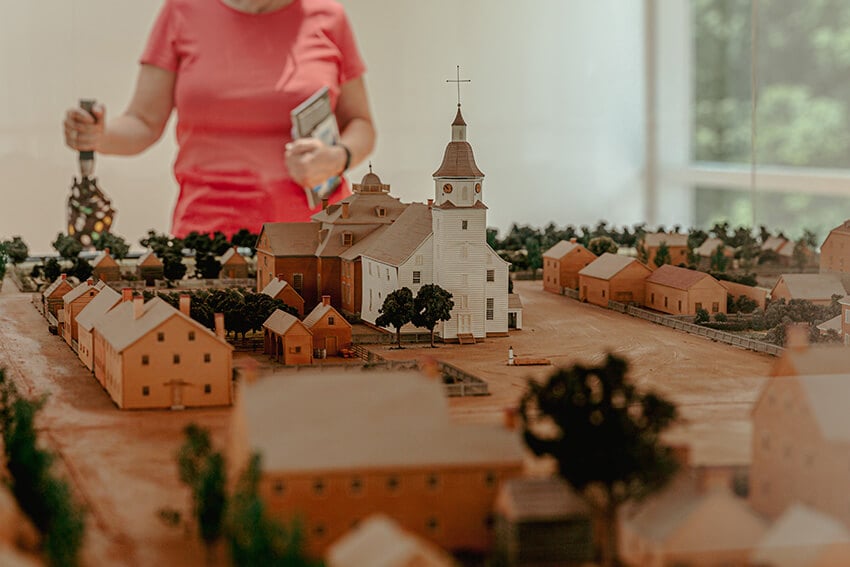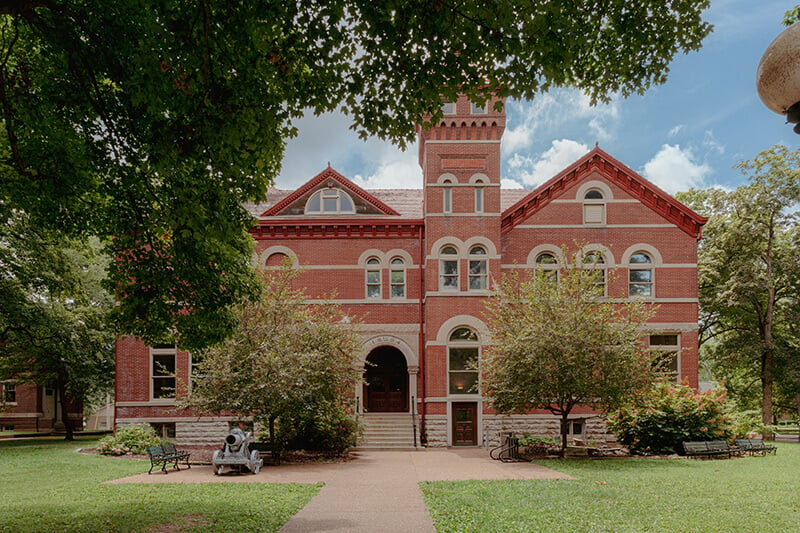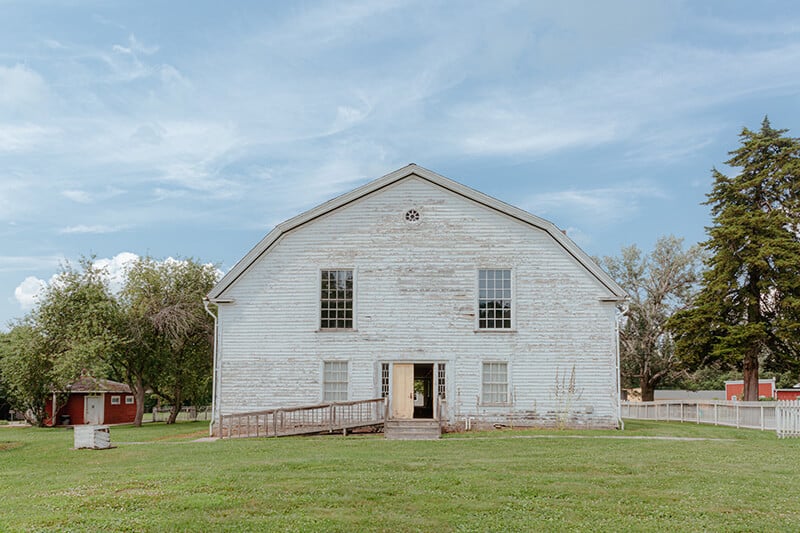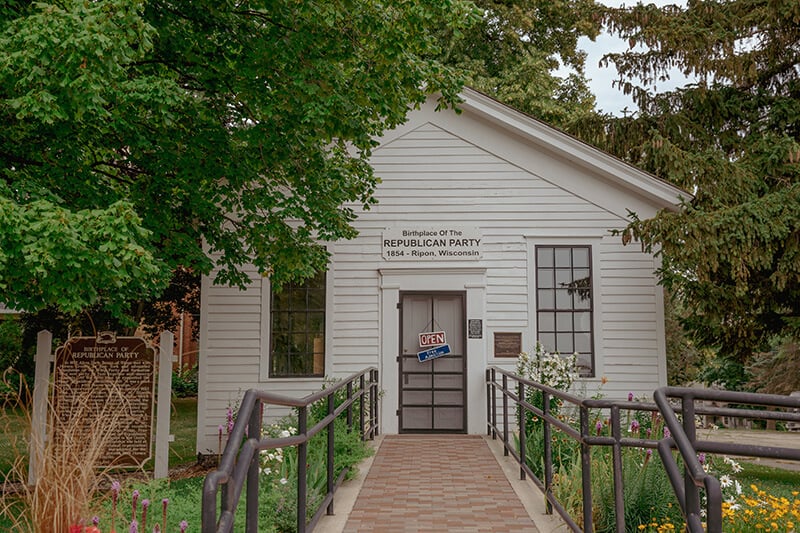The Other American Frontier

My AC went out in the middle of July in Loveland, Ohio. Luckily, the local Meineke was having a slow day.
I initially assumed my accumulator was leaking—a quick fix—but the mechanic unraveled a string of successive problems, each concealing the next. Behind a scrapped compressor was a broken high-pressure cut-off switch, and then a faulty pigtail. Each part took hours to arrive and only delivered knowledge of what we needed to wait for next.
Outside the Meinecke lobby window, four lanes of highway bisected a familiar sprawl: Menards, Office Depot, Dunkin’ Donuts, O’Reilly Auto Parts, Chase Bank. Suburban Cincinnati’s commercial jungle would never let on that the land beneath it had once supported an anarchist commune.
Orson S. Murray founded Fruit Hills in 1845, near present-day Loveland, inspired by his personally-held principles of atheism, socialist feminism, and economic cooperation. Murray hailed from the radical abolitionist movement, writing in The Struggle of the Hour that slavery “makes men into brutes, driving and being driven, crushing and being crushed.” He railed against church, state, and property as “a trio of monsters” in his newspaper, The Regenerator, and cofounded a group called the Society for Universal Inquiry and Reform. Fruit Hills was one of several efforts by Universal Reformers to translate theory into a practical utopia on the rural American frontier.
Inland America is pocked with the unmarked graves of communitarian utopias.
Murray once wrote that “Bibles and Constitutions are only the necessities of ignorance—things to be changed—to be outgrown and displaced by better things.” Change seems to have gotten the best of Fruit Hills, however; the commune collapsed within seven years. “All the necessaries of life could be raised in abundance,” wrote one contemporary observer, “but the laborers were mostly unused to agriculture and in many instances lacked industry.” From the vantage of the Meinecke lobby, no definition of success seemed generous enough to encompass the project’s fate.
This story is fairly typical. Inland America is pocked with the unmarked graves of communitarian utopias—primitive socialist and communist experiments—that tried to rebuild the world on what was assumed to be virgin soil. Ephrata, Pennsylvania; Germantown, Tennessee; Utopia, Ohio; Brentwood, New York; Iowa’s Amana Colonies: these and many other towns were originally settled by communalists with lofty visions of abolishing private property, quashing material inequity, and transcending divisive individualism.
It makes sense that those seeking the fringe of a New World might be driven by powerful ideological convictions. But while European settlers dreamed of abolishing old hierarchies in the map’s blank spots, these blanks were always a fantasy. The allure of self-directed freedom in unsullied lands largely folded back into a vanguard of dispossession and genocide, with naïve radicals paving the way for the extension of the very structures they had hoped to escape. Their intentions complicate the mythic image of a land settled by rugged individualists, but their ultimate fates suggest bleak prospects for liberation conceived as escape, rather than transformational conflict.
With my AC in working order, I pressed on from Loveland to survey what remained of the utopians’ dreams.
A Tale of Two Harmonies
New Harmony, Indiana was settled twice: first by the Harmony Society, a dissident religious group, and then by utopian socialist Robert Owen, a philanthropic industrialist whose work inspired dozens of communes across Britain and the United States. The Harmonites believed that the Second Coming of Christ would occur within their lifetime; the Owenites believed in abolishing the ills of capital without displacing the ruling class. Despite their apparently opposed precepts, they inhabited the same buildings, drew overlapping conclusions, and clung to similar myths.
Self-styled refugees of moral rot, the original Harmonites sought southern Indiana for its isolation. Some seven hundred of them relocated there from Pennsylvania in 1814, aiming to live according to a particular interpretation of piety. Property was held in common, labor was performed according to ability, and its yield was distributed equally. In an effort to restore “the harmony of male and female elements in humanity,” sex and marriage were discouraged, if not banned outright.
Despite their industrious work ethic, the Harmonites remained economically tethered to the wider world and often struggled with life at its edge. Their settlement suffered harsh bouts of malaria, conducting trade meant traversing a long, marshy river, and frontier neighbors did not always abide their unusual lifestyle. The group ultimately returned to Pennsylvania after a decade, leaving over 130 communal structures in their wake. What they built from scratch, Robert Owen bought with money.
“If we cannot reconcile all opinions, let us endeavor to unite all hearts.” An engraving in New Harmony attributes this line to Owen, but in fact he borrowed it from Nicholas Vansittart, the son of a British colonial administrator and joint secretary of the queen’s treasury. Owen was not quite so highborn, but his hopes hinged on the sympathies of Vansittart’s class. Having witnessed the exploitative horrors of early industrialization, he prophesied that reform would flow from the reason and good will of those in power, “that truly just spirit which knows no exclusion.” Owen believed that industrial capitalism could only survive in the long run through the parallel evolution of a “New Moral World” built around economic collectivization, scientific rationalism, and popular education. His communes were early efforts to realize such a world.
Owen’s most famous model society was in New Lanark, Scotland, but New Harmony was his most ambitious. He purchased the land with philanthropist William Maclure in 1825 and populated it with a cohort of artists, educators, and scientists. Owen’s followers took up the Harmonites’ housing and tilled the same communal fields, adopting a constitution that emphasized common property, freedom of action, and preservation of health. Childcare was reframed as a collective responsibility, not only because parents were seen as selfish, but because they were believed to carry the old world’s traumas in their patterns of thought. “Children aged two to five were taken away from home and placed in a controlled environment,” said Terri Axton, a modern-day New Harmony resident. “They were taught to get along with others and be polite.”
In Women in Utopia, Dr. Carol A. Kolmerten notes that female New Harmony residents were among the first to observe that Owen’s lofty proposals did not always translate to pleasant living conditions or common sense, writing that “married women who had come to New Harmony with their husbands . . . spent much of their free time plotting their own private rebellions.” In elevating impersonal “rationality” and utilitarian materialism above domestic labor, aesthetic considerations, and personal comforts, Owen’s utopian socialism not only diminished traditional spheres of women’s autonomy but arguably minimized the very qualities that ultimately give meaning to life.
New Harmony was formally dissolved in 1827, just two years after its optimistic launch. “Many here were unprepared to be members of the community of common property and equality,” observed Robert Owen in a farewell address. The project’s failure is variously pinned on its leader’s off-putting zeal, the untenability of economic collectivization, and the fact that its settlers were softies without the constitution for subsistence farming. But there is also the fact that Owen himself hardly spent any time there, preferring to stay back and promote the project on the East Coast and in Britain. He may have initially conceived New Harmony’s second coming, but was he really an authority on its failure or success?
New Harmony’s communal structure formally dissolved in 1827, but its residents did not simply disappear. Educator William Maclure traveled to New Harmony in 1826, for example, but it wasn’t until 1838 that he established the town’s “Working Men’s Institute,” a hybrid library and museum for “mutual instruction” that aspired to educate and empower the working class. The model proliferated across Indiana and neighboring Illinois, spawning 144 such institutes that were, for the most part, eventually absorbed into their respective state library systems. Josiah Warren, sometimes regarded as the first American anarchist, was another early resident of Owenite New Harmony. But it wasn’t until the 1840s that he opened the town’s “time store,” an experimental retailer that exchanged goods for “labor notes” representing agreements to perform work. “People would not buy at home, but came twenty, twenty-five, and even one hundred miles, to the time store,” he observed at the time.

New Harmony did not dramatically transcend the capitalism, but it remained a site of leftist experimentation for some time, and the ideas at its core played a role in establishing significant public works. One of Owen’s sons, Robert Dale Owen—who oversaw much of the day-to-day operations at New Harmony—was later elected to represent Indiana in congress. In this capacity he introduced legislation that founded the Smithsonian Institution in 1846, enshrining the Working Men’s Institute’s public education philosophy on a national scale.
Reconnecting New Harmony’s history with these long-term effects somewhat vindicates the project’s utopian designs, suggesting that a broad and radical vision may have been necessary to create such enduring institutions. Still, even if New Harmony’s collapse was more gradual than Owen asserted, it was nonetheless slowly reabsorbed into mainstream society. The project’s fatal shortcoming was not its imagined ends, but its means: Owens’s excessive faith in morality over muscle. It is one thing to speculate what might be done with power, but quite another to win it.
Those Crazy Swedes
Three-hundred miles northwest of New Harmony, Bishop Hill, Illinois is plastered with the Swedish flag. The general store stocks imported Swedish candies; the diner serves pancakes with lingonberries. The town has become a minor regional tourist destination for its association with mid-to-late nineteenth century Swedish migration to the American Midwest—of which I am also a product. While the king of Sweden personally attended Bishop Hill’s 150th anniversary in 1996, the monarchy was less supportive of its founders.
Bishop Hill was settled as a pietist commune in 1846 under the leadership of self-styled prophet Erik Jansson. Like the Harmonites, Jansson railed against the Lutheran church and preached a communistic flavor of Christian perfectionism. In contrast with Lutheranism’s self-flagellating embrace of imperfection, Jansson preached that eternal salvation, health, and earthly rewards would come only to those of pure faith. Cultish by today’s standards, the Janssonists were fairly typical of pietist sects at the time, stripping away secondary texts and aiming to live strictly by the Bible’s dictates. After coming into conflict with the Swedish government, Jansson and some twelve hundred followers crossed the Atlantic to create a “New Jerusalem” on the American frontier.
Their grandiose optimism, however, quickly met western Illinois. Hundreds of Jansson’s followers perished or defected during the long trek; only about four hundred made it all the way, and a hundred more died during the first winter. The settlement nearly collapsed when Jansson was murdered in 1850, but it managed to re-stabilize under new leadership. Power was transferred to a group of trustees who ran Bishop Hill as a centralized commune, overseeing its growth into a regional hub for crafts, agriculture, and commerce. Land was held in common, residents lived in collective housing, and agricultural profits were shared equally. Having overcome the perilous early years, the commune prospered until its trustees elected to dissolve Bishop Hill’s collective ownership structure in 1861. At that time, almost everything in Bishop Hill was measured, counted, and divided—even women and children received shares, which was then a radical notion.
“I would definitely call them a cult,” said an attendant at the Bishop Hill Heritage Association’s archive, which inhabits a former commune building. “They had bad leadership, or maybe too much leadership.” The fate of Bishop Hill’s socialistic experiment is typically evoked as a warning about the sinister authoritarianism lurking behind collectivization. But in an essay on “those crazy Swedes” of Bishop Hill, librarian Troy Swanson argues that the commune fell victim to the success, rather than failure, of its socialized economy. “After the devastating crisis of 1849 and 1850,” he writes, “Bishop Hill appeared to be the utopia these Swedish immigrants had envisioned.” Swanson cites the colony’s changing population as a key factor in triggering its downfall. Newcomers were less committed to the project, and some wanted to enrich themselves from the arrangement. The trouble, it seems, was not with the true believers.
During my visit, I stayed in a local bed and breakfast run by Brian “Fox” Ellis, who hosts visitors in a building that was once the commune’s hospital. “Fifteen years is a pretty good run for a commune,” he said. “No commune survives the murder of their charismatic leader, but they had their best years after [Jansson] was shot.”
Fox estimated that 20 percent of Bishop Hill’s modern-day residents are descended from the original Janssonist settlers. I met one of them, Marty Ray, who grew up and still lives in a home that was once the colony’s meat storage building. “Anything metal in the basement rusts,” she said, “because the wood is so saturated with salt from when they cured the meat.”

Ray spoke of her childhood in joyous terms of open arms and unlocked doors. “[The town] still has that utopian vibe,” said Fox. “When we first moved here, people just showed up with paintbrushes and said, ‘put us to work.’”
Misguided though it may have been, Eric Jansson’s religious utopianism answered genuinely repressive circumstances, and his disciples showed promise in adapting beyond their leader’s cult of personality. But while Bishop Hill’s modest success demonstrates the fortitude of small-scale collectivization, running away was never a realistic fix; the Old World was always destined to catch up. In the end, the industrial system easily reabsorbed Bishop Hill, along with countless other microcosmic American “socialisms.” The town has remained small enough to cohere a warm and trusting community, but neither faith nor familiarity can reform power at scale.
Shadow of the Phalanstère
Ripon, Wisconsin is an unassuming city of around eight thousand with a cutesy downtown drag. It’s an appealing setting for the town’s crown attraction, the “Little White Schoolhouse” where the modern Republican Party was formed in the summer of 1854. The streets ooze nostalgic Americana, but memory is selective.
Present-day Ripon was first settled in 1844 as Ceresco, or the Wisconsin Phalanx, according to the communitarian philosophy of Charles Fourier. Fourier’s socialism, like Owen’s, was fixated on education reform, but he argued for reorganizing society around human desires, not the other way around. Where Owen saw human nature as essentially plastic, something to mold toward higher ends, Fourier believed it was fundamentally benevolent, worthy of discovery and liberation. His views were embraced by radicals with a clearer sense of class antagonism, informing the revolutionary Paris Commune among other movements.
Fourier advocated for anchoring humanity to self-sustaining agrarian units of 1,620 people living in self-contained “phalanstères,” a French portmanteau of phalanx and monastery. He saw a degree of social inequality as unavoidable but insisted that the best remedy would be to keep societies small enough to recognize and counterbalance injustice on an ad hoc basis. The phalanstère was envisioned as a vehicle for empathy to overtake coercion as civilization’s driving force, unifying perspectives and blurring lines between work and play.
These ideas were immensely popular in the United States and, significantly, earned support from socialist congressman and newspaper magnate Horace Greeley, who commanded a national audience as founding editor of the New-York Tribune. Greeley encouraged young idealists to migrate west, where the expanding frontier provided opportunities for experimental forms of social organization. A few dozen Fourierist phalanxes formed in the United States in the 1840s, and Ceresco was among the most successful.
The Wisconsin Phalanx peaked with about two hundred members, who lived in a cooperative longhouse and farmed some two thousand acres. Meals were prepared in common—mostly by women, who were paid lower wages than men—assets were held collectively, and while the community was not explicitly religious, it tolerated religion so long as community members were willing to lay it aside for a united social effort. By most accounts, the phalanx remained prosperous up until the end: Ceresco disbanded in 1850, and its members were absorbed into the new town of Ripon three years later. An 1885 Chicago Times autopsy concluded that the split owed more to some members’ “love of wealth and speculation”: self-interested opportunism rather than functional breakdowns or ideological spats. As with Bishop Hill, the commune’s end was as much a product of its success as its flawed precepts. “Human nature was the rock on which this fine ship split,” wrote observer Everett Chamberlain, “as did all other argosies bearing the banner of Owen or Fourier.”
At the same time, as with Owenite New Harmony, the Wisconsin Phalanx’s members did not simply abandon their ideals with the commune’s dissolution. Alvan Bovay, an abolitionist lawyer, member of the 1840s “Anti-rent” movement, and friend of Horace Greeley, only arrived Ceresco in 1850, just as it was beginning to come apart. Bovay had previously served as secretary of the National Reform Association (NRA), an organization that Friedrich Engels singled out in The Principles of Communism as a natural ally for would-be communist revolutionaries in America. Disappointed to find Ceresco coming undone, Bovay nonetheless stayed in Ripon to oversee an addition to the town that included a little white schoolhouse on former phalanx land.
The Wisconsin Phalanx attracted a politically engaged migrant population, many of whom were alarmed at the looming Kansas–Nebraska Act of 1854, which threatened to reverse the Missouri Compromise and open the door to slavery’s westward expansion. Bovay and a group of former phalanx members held a meeting in the schoolhouse shortly before the law’s passage, resolving to form a new party focused on resisting the expansion of slavery. They called it the Republican Party, leveraging connections to Horace Greeley to propagate the organization across the country.

Today, the one-room schoolhouse where this meeting took place is a small museum of GOP history. It features a minor display about the phalanx but treats the commune as a local oddity rather than a feature of the party’s formation. In fact, many people involved in the party’s genesis (“Radical Republicans” in the GOP’s early years) quickly departed from the national line, splitting to form the short-lived Liberal Republican Party in 1872. In what feels like obfuscation, the schoolhouse had been physically uprooted from its original location and moved to a new site near Ripon’s cutesy present-day downtown.
A mile away, the phalanx site is almost completely buried under a residential neighborhood. The only commune building still bearing a recognizable form is the second, smaller cooperative longhouse, which was partitioned into private apartments and stands in a state of relative disrepair. The lack of interest in preserving Ripon’s communitarian heritage is a shame, as it has far more to do with what actually transpired there than the GOP’s long trajectory does. Rummaging around the ruins of Ceresco, I pictured myself as a bizarro Dinesh D’Souza, unearthing the Republican Party’s secret utopian socialist history. Modern Republicans still evoke “the party of Lincoln” but, in Lincoln’s day, the party shared a clear intellectual linage with the Paris Commune.
If the Wisconsin Phalanx “failed,” it was not for a lack of lasting impact. After all, its vision was central to uniting the people and ideas that converged into one of America’s two enduring political parties. But that party was almost immediately lost to institutional inertia, and in the long run, unmoored to the point of unrecognizability. It is not enough to simply walk away from preexisting hierarchies, but it can also be fatal to meet power on its own terms.
Seeds of Fruit Hills
America’s forgotten utopias carry a delicate thread of radicalism through an otherwise genocidal history of U.S. expansion, even if they falsely imagined the western frontier as a blank slate, free from the trappings of history. Their stories contradict much of the frontier’s official mythology, but it is also important to remember why they were forgotten.
The best way to honor the memory of America’s forgotten utopians is to absorb their laudable ideals alongside the ultimate shortcomings of their methods.
The socialisms of Robert Owens; Charles Fourier; and Claude-Henri de Rouvroy, Comte de Saint-Simon were most famously called “utopian” by Friedrich Engels to distinguish their ideas from those of his and Marx’s. “One thing is common to all three,” Engels wrote in 1880. “Not one of them appears as a representative of the interests of that proletariat which historical development had, in the meantime, produced.” Engels credited the utopian socialists to an extent—their work had a clear influence on early Marxist thought—but argued that their idealism failed to engage the underlying dynamics of history. Owen introduced “transition measures to the complete communistic organization of society,” he wrote, but no means of delivering them. The utopians’ experiments were voluntary associations in direct competition with the old mode of production, which they were vastly incapable of out-producing. In the long run, their efforts were reabsorbed, ultimately breaking ground for the expansion of a ruthless new empire.
Back in the Loveland Meinecke lobby, I looked out at suburban Cincinnati and considered Fruit Hills founder Orson S. Murray’s two universal imperatives: inquiry and reform. He clearly failed to achieve a sustained collective harmony by fleeing to an imagined autonomous zone at the imperial fringe—history shows that radical transformation often demands messy, direct confrontation—but it was strangely comforting to remember that, even there, people had once dared to boldly inquire. Perhaps the best way to honor the memory of America’s forgotten utopians is to absorb their laudable ideals alongside the ultimate shortcomings of their methods. If nothing else, ignorant, enthusiastic idealism furnishes a foundation to iterate upon.
If I had known it would take all day to fix my AC, I probably wouldn’t have taken my car into the shop in the first place. But in hindsight, I am glad that I did.